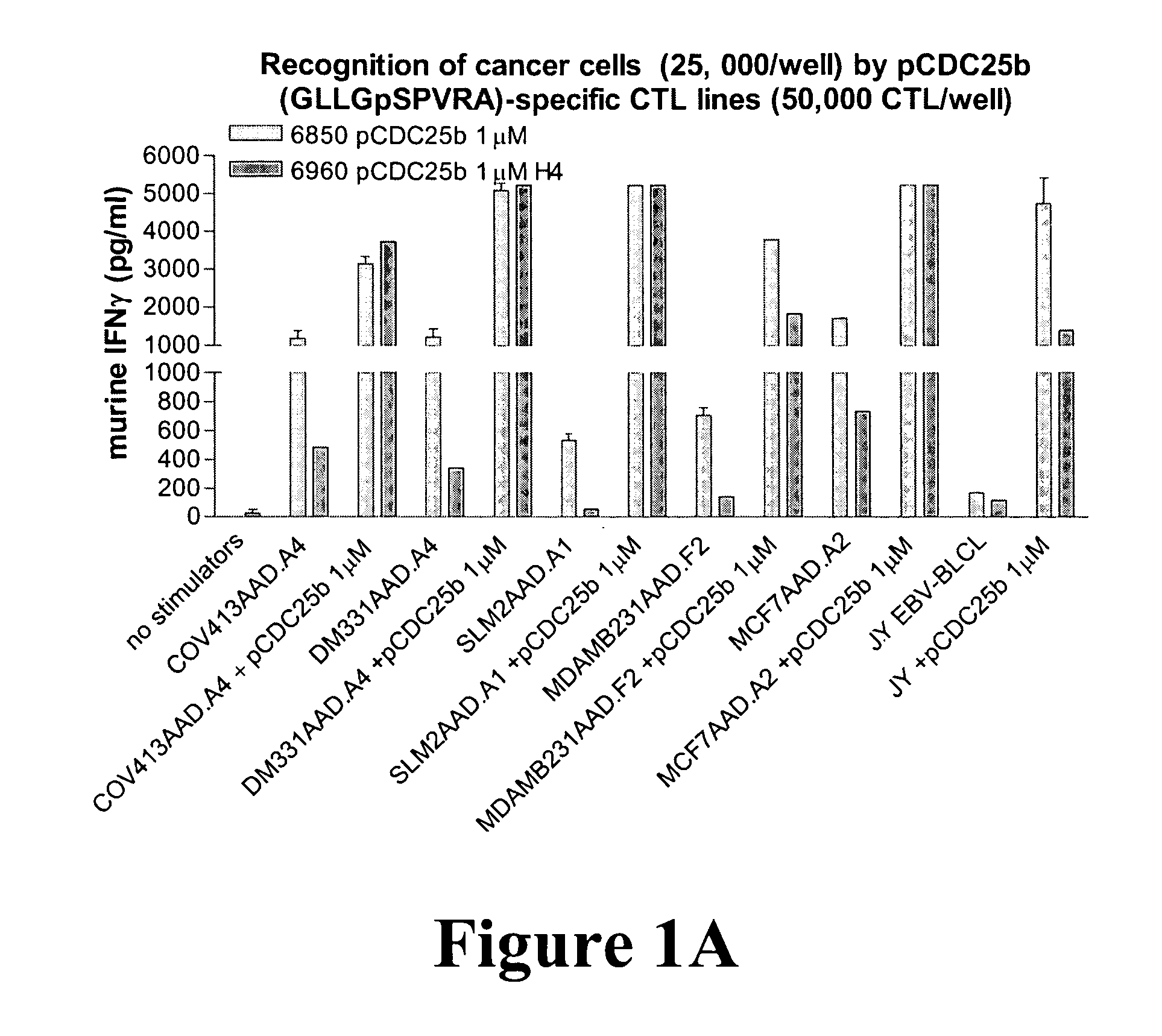Phosphopeptide antigens associated with MHC molecules
a technology of phosphopeptides and antigens, which is applied in the field of phosphopeptide antigens associated with mhc molecules, can solve the problems of the exact phosphorylation sites of many proteins, as well as their phosphorylation state, which remain unknown
- Summary
- Abstract
- Description
- Claims
- Application Information
AI Technical Summary
Benefits of technology
Problems solved by technology
Method used
Image
Examples
example 1
[0094] Phosphorylated peptides were extracted from melanoma cell lines that express either or both of HLA-B7 and HLA-A*0201, identified by mass spectrometry to be differentially displayed on melanoma versus a control B cell line, and then sequenced. The peptides were identified through the following procedure. Two melanoma cell lines and one B lymphoblastoid cell line were extracted with detergent containing buffer, and HLA-A*0201 class I MHC molecules were purified by immunoaffinity chromatography. Peptides were separated from the MHC molecules by extraction in acid and filtration through a 5000 dalton cut-off filter. Phosphopeptides were identified through analysis by microcapillary reversed phase high performance liquid chromatography tandem mass spectrometry. Sequences were determined from an analysis of collision activated dissociation spectra. Source proteins were determined from a search of protein and DNA databases. SEQ ID NOs:1 through 69 were identified (see Table 1). One ...
example 2
[0099] CTL specific for two of the antigen peptides were generated by long term culture with the peptides. Two CTL lines specific for the antigen peptide GLLGpSPVRA, lines 6850 and 6960, SEQ ID NO: 13, and two CTL lines specific for the antigen peptide RVApSPTSGV, SEQ ID NO: 14, lines 5183 and 63 were used to detect these two antigen peptides on cancer cells. The phosphopeptide-specific CTL (50,000 CTL / well) were incubated 24 hours with the following cancer cell lines or EBV-transformed B lymphoblastoid cell lines (BLCL) (25,000 cells / well): COV413.AAD.A4 ovarian carcinoma, DM331.AAD.A4 and SLM2.AAD.A1 melanomas, MCF7.AAD.A2 and MDAMB231.AAD breast carcinomas, and JY EBV-BLCL. Supernatants were harvested 24 hours later and evaluated for the presence of murine IFNγ (produced by murine CTL lines) by ELISA (eBioscience Ready-Set-go murine IFNγ ELISA kit). As a positive control, cancer cells were pulsed with the specific antigen peptide (1 μM) to show that they are capable of presenting...
PUM
| Property | Measurement | Unit |
|---|---|---|
| microcapillary reversed phase high performance liquid chromatography tandem mass spectrometric analysis | aaaaa | aaaaa |
| pH | aaaaa | aaaaa |
| microcapillary reversed phase high performance liquid chromatography tandem mass spectrometric analysis | aaaaa | aaaaa |
Abstract
Description
Claims
Application Information
 Login to View More
Login to View More - R&D
- Intellectual Property
- Life Sciences
- Materials
- Tech Scout
- Unparalleled Data Quality
- Higher Quality Content
- 60% Fewer Hallucinations
Browse by: Latest US Patents, China's latest patents, Technical Efficacy Thesaurus, Application Domain, Technology Topic, Popular Technical Reports.
© 2025 PatSnap. All rights reserved.Legal|Privacy policy|Modern Slavery Act Transparency Statement|Sitemap|About US| Contact US: help@patsnap.com



